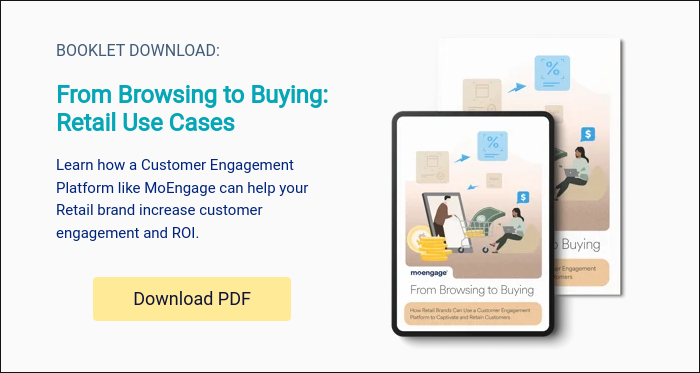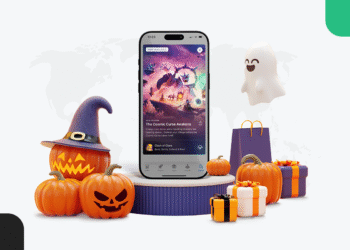Reading Time: 12 minutes
When a customer walks into a high-end, luxury store, the store assistant probably recognizes them after a few visits. They might remember what they bought last week, or suggest something that matches their style. That kind of personal attention is what keeps customers coming back, and Ecommerce personalization software is designed to recreate that same experience online, regardless of the store’s price point.
Done right, Ecommerce personalization makes digital shopping feel intentional, not random. It’s more than just about product recommendations or “customers who bought this also liked that.”
In most cases, it’s about making a customer feel like the website understands them. In fact, customers don’t compare your site only with your competitors’. They compare it with the best online experiences they’ve had anywhere. That sets the bar higher than most brands expect.
This blog examines how Ecommerce personalization software functions, what makes it effective, and why the decision to use it can influence customer loyalty to your brand.
5 Types of Ecommerce Personalization Software
As one of the latest Ecommerce marketing trends, personalization is not one single feature.
It branches out in different directions depending on what a brand needs most. Some retailers care about recommendations, others about search, and a few want the whole experience rebuilt around each customer. The software reflects that. Here are some of the main types of personalization software for Ecommerce that you’ll see in the market.
- Product Recommendation Engines: Ecommerce product recommendation engines suggest items based on browsing history, past purchases, or what similar customers looked at. They help in retail categories where choices are aplenty—fashion, electronics, and even grocery. The goal is fairly direct: surface products that a customer is more likely to buy instead of leaving them buried.
- Personalized Search and Navigation: Not every customer searches the same way. Some search with vague terms, others go very specific. Ecommerce personalization tools here adjust the ranking of results so they feel closer to what that customer probably meant. For example, two customers searching “running shoes” could see different top results; one based on price sensitivity, the other on brand loyalty.
- Dynamic Content and Landing Pages: The home page or product page doesn’t always need to look identical for everyone. Dynamic content personalization software changes banners, offers, or layouts depending on where the customer comes from, what device they’re on, or what they’ve browsed earlier. It works well for campaigns, seasonal promotions, or geographic targeting.
- Behavioral Targeting and Messaging Software: Sometimes, personalization isn’t inside the store, but around it are emails, app pushes, or on-site popups that react to customer behavior. If a customer abandons a cart, the system triggers a message. If they spend too long on a category, it nudges them with a discount or reminder. Such Ecommerce email personalization and that of other channels help reduce drop-offs and bring customers back into the funnel.
- Pricing and Offer Personalization Software: A less common but powerful type. Here, the software adjusts discounts, bundles, or loyalty rewards based on customer segments. It can mean a higher-value customer gets exclusive offers, while price-sensitive shoppers see different bundles. It’s more complex and sometimes controversial, but when done carefully, it raises both revenue and retention.
Different brands mix and match these Ecommerce personalization solutions. Some start small (usually with recommendations) after going through marketing personalization examples. Then they move into search or content personalization later. Others jump straight into multi-channel personalization if they already have enough data.
So the real question is not just what types exist but which one fits your business model. That leads straight into the next part: how to choose Ecommerce personalization software without getting lost in the noise.
How to Choose an Ecommerce Personalization Software
No brand chooses Ecommerce personalization software in the same way. Some start with curiosity, others with urgency because the site metrics keep slipping. The right decision rarely comes from a feature checklist alone. It’s more about whether the tool can work with what you already have, and whether your team will actually use it once the demo ends.
- Data and Integration Capabilities: Personalization doesn’t happen in a vacuum. The software needs data not just from the store but also from customer behavior, email engagement, purchase history, loyalty points, and location. If the tool can’t connect to those streams, the “personalized” journey will always feel thin. But how hard will it be to plug everything in? Some platforms connect quickly; others drag teams into months of integration work that no one budgeted for.
- Scale and Performance: Not every brand experiences the same website traffic. An omnichannel Ecommerce platform managing a few hundred daily sessions doesn’t face the same pressure as an app where thousands log in within an hour. A tool might work fast during testing, but stumble on Black Friday or a holiday rush. That’s when the question hits: will it stand up to real traffic, or will customers see lag and bounce? The shine of advanced features fades fast if the site slows down exactly when sales matter most.
- Depth of Personalization: There’s no single standard for “personalization.” Some tools stop at product recommendations, which is often enough to start. Others claim to rewire everything, from search and pricing to offers and content blocks. More power adds flexibility but also complexity, more rules to set, and more things that can misfire. Teams have to be blunt with themselves: Do we need the basics, or do we want to rebuild the whole storefront experience? Choosing something too lightweight can result in missed growth opportunities.
- Usability and Team Readiness: Even the smartest software will fail if it scares off the teams expected to run it. If every small change requires calling a developer, most marketers will just avoid logging in. If it’s overly simplified, then the software won’t give the flexibility needed to fine-tune campaigns. The balance matters. Can your team actually picture themselves using it each week, adjusting offers, testing variations? Or will it quietly sit idle after the launch excitement fades?
- Cost and ROI Visibility: There’s the sticker price, and then there’s setup, training, optimization, and time. Personalization is an ongoing effort, not a one-time buy. Will the returns show clearly in revenue, not just in abstract engagement numbers? And what happens when traffic grows? Some platforms look affordable in the beginning, then scale pricing so steeply that they end up costing more than they return.
Choosing Ecommerce personalization software is less about hunting for the “best” product on the market. It’s more about knowing your limits, your customers, and what kind of personalization you can realistically sustain. Once those pieces are clear, the focus shifts. The question becomes: what does the brand actually gain once the right tool is in place?
That’s where the benefits of using AI-powered Ecommerce personalization software start to show, not in theory, but in measurable outcomes that customers can feel and brands can analyze.
6 Benefits of Using AI-powered Ecommerce Personalization Software
When it comes to Ecommerce marketing automation, AI has changed how personalization works. Older systems relied on rules someone set; if a customer does X, show them Y. That works in some cases, but breaks down as customer behavior becomes more complex.
AI-powered Ecommerce personalization software doesn’t just follow pre-defined rules and logic. It learns from patterns across millions of interactions and adapts faster than a human team could. The benefits of that shift usually show up in a few clear ways as follows.
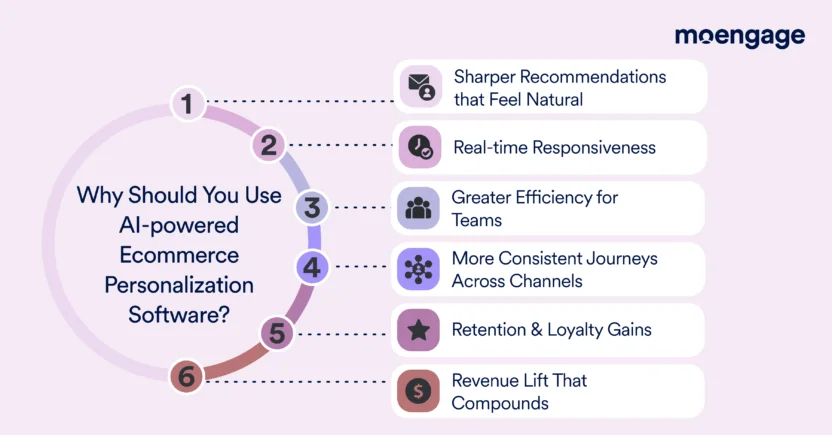
1. Sharper Recommendations that Feel Natural
Smart product recommendations are nothing new, but the quality of those suggestions makes all the difference. AI-driven systems analyze browsing paths, purchase histories, and subtle indicators like how long someone lingered on a product page.
That allows the software to connect dots that teams would likely miss. Instead of throwing random “similar items” on the screen, the recommendations feel intentional, almost as if the store knows the customer’s taste. This sense of relevance nudges customers to explore further, sometimes even buying products they weren’t planning to, but still find useful.
2. Real-time Responsiveness
Customer intent isn’t fixed. Someone who usually shops for luxury might, one evening, filter by “lowest price.” Static personalization would miss that shift and keep pushing premium items.
AI-powered Ecommerce personalization tools, on the other hand, can pick up on the change instantly. The search results reorder, offers adapt, and product carousels shuffle. It’s not flawless, but it’s far closer to the way a good salesperson adjusts mid-conversation. This responsiveness often prevents drop-offs, keeping customers engaged instead of frustrated.
3. Greater Efficiency for Teams
Marketers know the pain of building endless rule sets and segments. Without AI, personalization often eats up hours of planning and setup.
AI reduces that load. It does the heavy lifting of spotting patterns, clustering audiences, and testing variations. The team still guides the personalized customer experience strategy, but they don’t have to micromanage every condition. That way, whether it’s a small team or a large one racing against deadlines, they can spend less time clicking through setups and more time on creative thinking.
4. Consistent Journeys Across Channels
A customer doesn’t just live on one channel. They might discover a product through an email, check reviews on mobile, and later buy on desktop. With AI personalization for Ecommerce, you can connect all those touchpoints, so the experience feels coherent. If someone abandoned a cart on mobile, they might see a timely reminder on desktop, or you can send them a relevant offer by email using email personalization tools.
Consistency doesn’t always guarantee loyalty, but inconsistency almost always drives customers away. This is where AI-powered Ecommerce personalization software helps close the gaps.
5. Retention and Loyalty Gains
Recognition is subtle, but powerful. When customers feel a store understands them, they are more likely to return and make purchases.
AI enables that recognition at scale. It can trigger loyalty rewards at the right time, personalize content for high-value customers, and keep long-term shoppers engaged with offers that suit their history. And loyalty is never just about software, but the data suggests repeat purchase rates almost always improve when personalization feels genuine rather than generic.
6. Revenue Lift That Compounds
Executives often want one number: how much does this increase sales? The answer varies, but most brands see two consistent shifts: higher average order value and more frequent purchases.
It rarely explodes overnight. Instead, the effect builds gradually, session by session, as customers encounter experiences that make sense to them. Over months, those incremental lifts add up to a stronger revenue curve. It’s not dramatic at first glance, but the long-term compounding is where the real value hides.
So, the benefits aren’t only about shiny dashboards or clever algorithms. They’re about practical outcomes: more relevant experiences for customers, less manual work for teams, and measurable impact for the business. Once you start looking at it this way, the next step is less about whether AI-powered personalization works and more about where these tools can be applied in practice, through specific use cases that retailers already depend on.
5 Best Ecommerce Personalization Tools to Improve Campaign Engagement
There’s a crowded field of platforms out there to personalize the Ecommerce customer journey through your Ecommerce store.
But cutting through the noise usually means looking for tools that actually move the needle, not just in features, but in how customers feel and how campaigns perform. Below are a few standout Ecommerce personalization tools, starting with one that’s well-known for its omnichannel customer marketing.
1. MoEngage
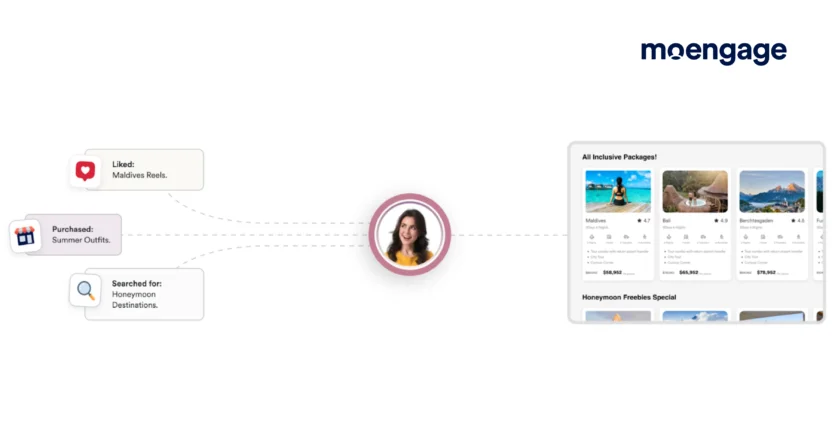
MoEngage is a customer engagement platform built to connect the dots between data, personalization, and real-time action. It’s more like the central system that tries to keep every customer touchpoint in sync, including email, push, SMS, in-app, WhatsApp, and even the website itself.
That sounds ambitious, and it is, but the logic is straightforward. Customers don’t wait around. If someone looks at your product today, you probably have a few hours, maybe a day, to catch their attention again. Not a week. That’s the problem MoEngage was built to solve.
What makes MoEngage one of the best Ecommerce personalization software is the unified view it delivers of each customer. Take the example of Beem, an AI fintech startup based in San Francisco, which used MoEngage to unify customer data across multiple touchpoints. The result? A 360-degree view of customer behavior and preferences, leading to better decision-making and 38% higher clickthrough rates for SMS messages.
You don’t just see “opened an email” or “visited a page.” You see patterns, where customers tend to drop off, what they usually buy next, and who’s likely to churn.
Then the AI engine starts making decisions for you: Send this person a push at 10:15 AM on Android, show that group a price-drop alert by email, or suggest a new offer to someone who hasn’t engaged in months. In most cases, it’s sharper than manual guesswork. And it learns over time.
Key features you can count on:
- Omnichannel journeys – Build flows that cover email, push notifications, SMS, in-app, on-site, and WhatsApp without juggling different tools.
- AI-led optimization – The system learns what to send, when, and to whom, boosting engagement without manual guesswork.
- Segmentation at scale – Create real-time segments based on customer behavior, purchases, app activity, and even predicted actions.
- In-depth analytics – Detailed dashboards that don’t just report opens and clicks, but also map campaign ROI and conversion drivers.
- Experimentation – Built-in A/B testing and control groups, so you can keep testing without slowing down execution.
How Pricing Works: Pricing kicks off with a free plan covering up to 10,000 Monthly Tracked Users (MTUs) and paid Growth and Enterprise tiers based on user volume and event usage.
Best for: MoEngage is the best fit for consumer brands that want to unify messaging across channels and don’t want their personalization strategy scattered across five different platforms. If you need cross-channel performance dashboards, automated reports, predictive analytics, custom dashboards, and other robust analytics capabilities, MoEngage is the ideal Ecommerce personalization software for your brand. It’s also the perfect choice for teams looking to save time with AI copy and image generation for campaigns.
2. Optimizely
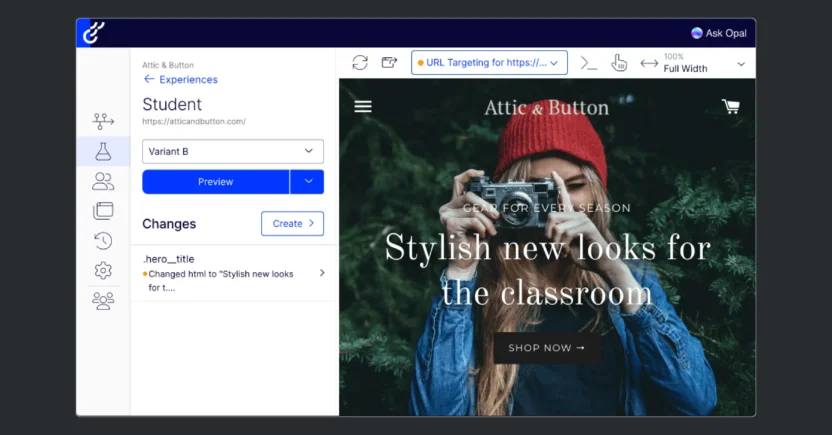
Optimizely’s roots are in A/B testing and experimentation. Over time, they’ve layered on personalization and content management to become a broader digital experience platform. The appeal is clear: you can experiment, personalize, and optimize, often all in one workflow.
How pricing works: Basic plans reportedly begin near $36,000 per year, while higher-traffic tiers, like 10 million monthly impressions, can range from around $63,700 to over $113,100 annually, and enterprise setups may breach $200,000+.
Key features: Robust multivariate and A/B testing, behavioral targeting, feature flagging, content personalization, and site experimentation tools. Great if you want to tweak and test campaigns on the fly and iterate quickly.
Best for: UX-focused teams and growth marketers who treat personalization like an ongoing experiment, especially those who A/B test constantly and want the software to support that mindset.
3. Nosto
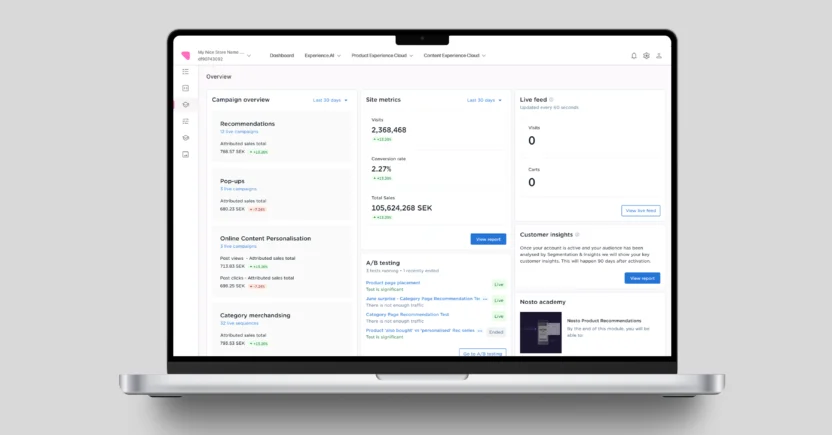
Nosto is a personalization platform built for Ecommerce brands, and it leans heavily on making shopping experiences more relevant. It handles product recommendations, search, and merchandising in one place, which means less stitching together of tools. What stands out is how it adapts product displays to browsing intent, whether someone lands on a homepage or drills down into a category page.
How pricing works: Nosto offers tiered plans such as an Incubator plan starting at roughly $800/month for mid-market use, with a Basic tier around $1,500/month, depending on features and traffic.
Key features: Personalized product recommendations, AI-driven merchandising, search that adjusts to customer behavior, and customer segmentation. Integrations with Shopify Plus, Magento, and other platforms are built in, which makes setup less painful.
Best for: Retailers that want ready-to-go personalization for catalog browsing and product discovery, without investing months in custom development.
4. Personyze

Personyze positions itself as a personalization and recommendation engine with a fairly broad feature set. It’s not as large-scale as some of the enterprise-first tools, but it does cover the basics well enough, including personalized banners, content blocks, and product recommendations on Ecommerce sites. The platform is often appreciated for its simplicity, especially for teams that don’t want to manage heavy integrations.
How pricing works: Starts at $250/month (Lite), $450/month (Power), and around $1,450/month (Enterprise), with annual discounts available.
Key features: On-site personalization, recommendation widgets, dynamic content insertion, and visitor segmentation. It also allows non-technical marketers to launch campaigns fairly quickly, though advanced data-driven orchestration is somewhat limited compared to bigger players.
Best for: Usually best for small and mid-sized online stores that want robust personalization but don’t want to pay enterprise costs. It works well for teams that need versatility but also have to stay within budget.
5. Dynamic Yield
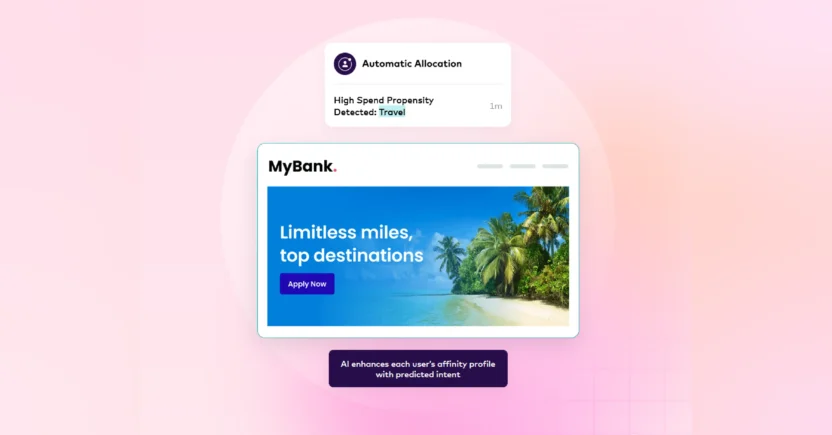
Dynamic Yield, now under Mastercard, is considered a more heavyweight personalization tool, but still workable for marketing teams. It supports A/B testing, product recommendations, and personalization across web, mobile, and email. The draw here is that it reduces dependency on engineering teams, so campaigns can actually move faster.
How pricing works: The starting price is about $35,000 per year for the basic subscription tier, with costs scaling up based on modules and usage.
Key features: Omnichannel personalization, behavioral targeting, recommendation models, and testing frameworks. Dynamic Yield’s machine learning layer constantly adjusts campaigns in real time.
Best for: Brands that want a robust personalization suite to test, iterate, and refine, but it’s not for brands that need comprehensive analytics capabilities.
MoEngage: A Customer Engagement Ecommerce Personalization Software
MoEngage for Ecommerce is often mentioned in conversations about Ecommerce personalization software because it balances data with action. With MoEngage, teams don’t just get dashboards full of numbers; instead, they can actually set up journeys that adapt as customers click, browse, or drop off.
That mix of analytics and execution is what makes it stand out for most brands trying to connect across email, app, web, SMS, and push, all through its omnichannel marketing platform.
Want to see whether it fits your setup? Book a demo today and test it with your own customer scenarios.
The post Top 5 Ecommerce Personalization Software for B2C Marketers appeared first on MoEngage.

